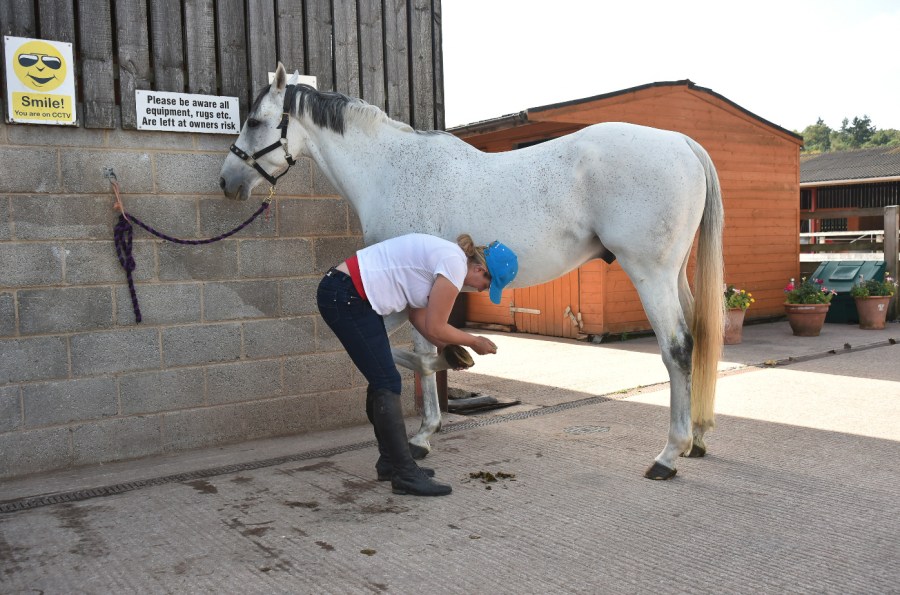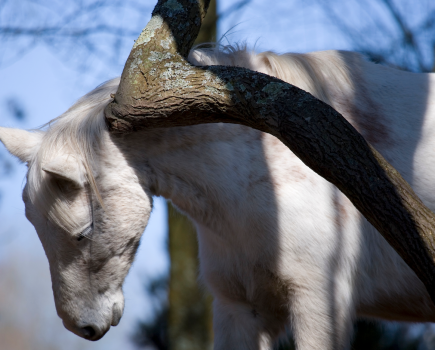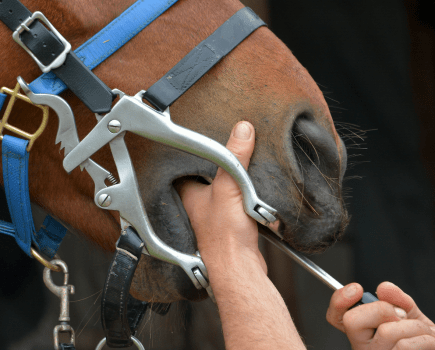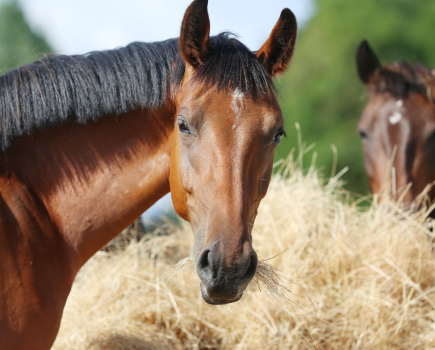There’s a very famous saying: “no foot, no horse” — but what does it actually mean? In basic terms, it summarises how important correct horse hoof care is every single day. Whether they are a newborn foal or older, allowing horse hooves to become overgrown, unbalanced or hoof wall quality to deteriorate will eventually cause pain and lead to lameness. Suddenly you find yourself with a horse that is unrideable and, chances are, a hefty vet (and farrier) bill to boot.
Horse hooves grow fastest in the spring and autumn, coinciding with shedding or growing a winter coat to prepare for the change in season. In the summer and winter, hoof growth slows down. However, maintaining routine farrier visits for a regular hoof trim or a new set of shoes remains key all-year round. Of course, changing seasons means variable weather conditions too, which has an enormous impact on hoof quality. (More on this later)
How often should a farrier visit?
Horses need re-shoeing anywhere between four and 10 weeks apart. For those who are unshod (barefoot), they should still be seen by a farrier or trained equine podiatrist at regular intervals for a possible trim and to check their general hoof health.
“How often your horse needs to be shod depends on their breed and the type of work they do. Native breeds in light work tend to go longer between farrier visits, compared to a Thoroughbred that does a lot of roadwork,” explains Northampton-based farrier Reubin Underwood.
Reubin’s best piece of advice is to check your horse’s hooves on a daily basis. Make it a part of your normal daily routine — perhaps when grooming or changing rugs in the morning and evening — as you know your horse best and so will be able to spot a potential problem early.
Tips for good horse hoof care
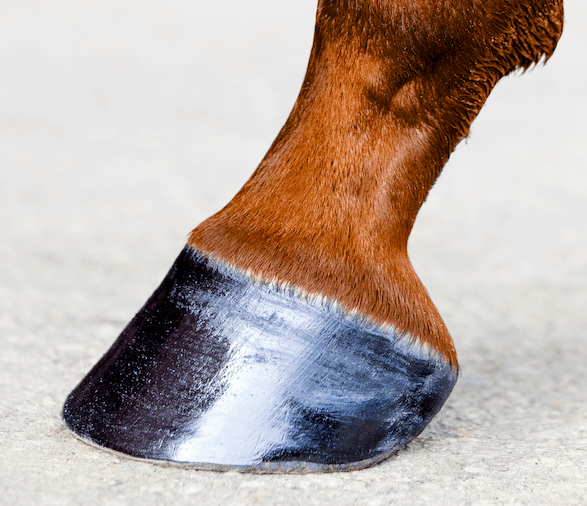
This is a nicely trimmed and cared for hoof
A balanced diet aids the growth of healthy hoof. Your farrier may recommend that you feed a hoof supplement, many of which include biotin, especially if your horse has limited turnout and is lacking in the natural, hoof-friendly vitamins and minerals found in grass.
Regularly wash your horse’s frogs with salt water to prevent infection and check it daily for any wounds as part of your hoof care regime. Always dry the sole of your horse’s feet well afterwards and avoid allowing your horse to stand on wet bedding or ground for too long, as this can cause thrush.
Apply a hoof dressing a couple of times a week, to help keep the hoof wall in good condition. Speak to your farrier about what’s best to apply and when as it is weather dependent. During a hot, dry spell, hooves may need moisture to help prevent cracking and/or the hoof wall becoming brittle, while in wet weather they need to be given time to dry out.
Reubin advises the following daily hoof care routine:
- Pick your horses feet out at least once every day. You should always pick out hooves before riding and after riding, as well as when the horse is brought in from the field. Picking feet out regularly helps to prevent thrush and removes any dirt/stones that could cause bruising.
- Apply a hoof dressing to protect and nourish the horn, so to avoid cracks and flakes. Your farrier will be able to advise what sort of hoof ointment will suit your horse best.
- Check that all shoes are still in the correct place, aren’t loose or overly worn, and that the clenches haven’t risen.
Horse hooves and the weather
The weather affects a horse’s hooves more than you probably think, and it should influence your hoof care regime too. Particularly in countries where the weather can throw unexpected curve balls — thunderstorms in the middle of summer, for example — the constant change from wet to dry and back again can wreak havoc on horse hooves.
“It’s the sudden change in conditions that causes the issues,” explains Worcestershire-based farrier Jack Climo Dip WCF. “It takes on average three days to a week for horse hooves to adapt, so when the weather is constantly changing, it can leave the hoof vulnerable.”
Problems arise after a wet spell, when the soles of the horse’s hooves become soft and then the ground suddenly hardens up after a prolonged dry period when the moisture content is low. This leaves horses exposed to bruised soles and hoof abscesses.
“In these cases, be careful where you ride for a week until your horse’s feet have caught up with the current conditions,” advises Jack. “Avoid stony, hard and unlevel going.”
Moisture levels in horse hooves
It’s important that your horse hoof care regime is geared towards maintaining a consistent moisture level.
“Horse hooves can adapt very well to long dry periods or to constant wet, like most of our winters here in the UK, but what the hoof struggles with is wet-dry-wet conditions, which are typical of a British summer,” states Jack. “When the hoof is exposed to moisture it expands and softens, whereas when it is dry it contracts. Changes in moisture levels means the hoof wall is constantly expanding and contracting, which can lead to loose nails, hoof wall cracks and foot abscesses.”
Jack echoes Reubin’s advice, which is to apply a hoof moisturiser or oil twice a day (ideally after picking hooves out) to help keep the hooves well moisturised during a dry spell.
Be aware that the type of bedding you use will also have an impact on the moisture in your horse’s hooves. Shavings generally offer the optimum moisture levels, whereas straw can dry the hooves and increase the risk of thrush in the frogs.
How to add condition to horse hooves
To help maintain a consistent moisture content in hooves, Jack recommends applying a moisturising hoof conditioner to help trap moisturiser in and prevent hooves from becoming dry and brittle.
“If your horse is out overnight, apply the oil when they come in as they’re likely to have moisture from the grass dew on their hooves and the oil will help to keep the moisture in,” advises Jack. “If the hooves are dry, you could spray them with the hose to apply some water before adding the oil. For very soft soles that bruise easily, you could apply iodine or a hoof hardener.”
Beware your horse stamping their hooves due to flies in summer. This can cause bruising, concussion and cracks in the hoof wall. Consider stabling your horse at peak fly times and use fly sprays and fly rugs, including when they’re in the stable.
Signs of a well-shod hoof
A well-shod hoof is the end result of good horse hoof care, but do you know what that looks like? Here are three things to look for:
- When your horse is stood square and on level ground, look at their front feet. Both hooves should look as though they’re the same length, and the coronary bands should be parallel to the floor. Then look at the hind feet for the same signs.
- Pick up each foot and examine the shoe. It should be smooth with no kinks or bumps, and nicely rounded towards the front. Pointed shoes will impact on your horse’s break-over movement. Shoes that are worn at the front, particularly on the hind hooves, are a sign the horse has been dragging their back feet.
- Look at your horse’s heels on the front feet. Every horse is different, but as a general rule if their heels are are upright, their shoes will need to stick out less at the back as they won’t need as much support as a horse with an under-run heel. However, heel support on the back feet tends to be different, as this is where the horse gets their speed and power from. To help with this, your farrier may leave more shoe sticking out of the back of the foot to better support the heel, in turn helping the horse with their movement.
Signs a horse needs new shoes
Having new shoes at the correct intervals is another part of good horse hoof care. The following are good indicators that your horse needs to be seen by a farrier:
- The clenches have risen away from the hoof wall. The clenches are the top of the nails that you can see on the outside of the hoof.
- The hoof has visibly overgrown the shoe at the front or sides. Overgrown horse hooves should always be avoided.
- The shoe has become worn and thin, so your horse has no grip on smooth surfaces.
- The shoe is twisted or has become loose — or it’s come off completely.
What does a balanced hoof look like?
You’ll often hear farriers (and vets) refer to a balanced hoof, and this is critical in order to maintain soundness. In a nutshell, it refers to the way your horse’s hoof strikes the floor (all four hooves must do this with equal impact). If your horse’s footfall is uneven — for example if one heel strikes before the other heel does — it will cause uneven stress within the foot and lower limbs. This, in turn, will affect your horse’s gait and limit their mobility.
In a balanced hoof, the pastern and the front of the hoof run at the same angle to one another. If you look at the hoof side-on, there should be a straight line from the fetlock joint down to the bottom of the hoof. The foot should also land on the ground evenly, not one side before the other.
Break-over is the moment your horse’s hoof starts to leave the ground in walk, with their heel rising first before the toe. If the hooves are unbalanced, your horse will struggle with this movement and may become unsound. This is usually the result of your horse’s toes becoming too long, or the shoe no longer fitting properly. Your farrier will shape your horse’s hoof in a way that aids its break-over, usually by rounding or squaring it off.
It’s vital that your horse’s heel is supported correctly by their shoe. If a shoe doesn’t extend to the back of the heel, there’s no support for the bones, tendons and ligaments in the back of your horse’s leg. This also puts stress on other parts of the limb, limiting your horse’s movement and affecting their long-term soundness.
Overgrown horse hooves
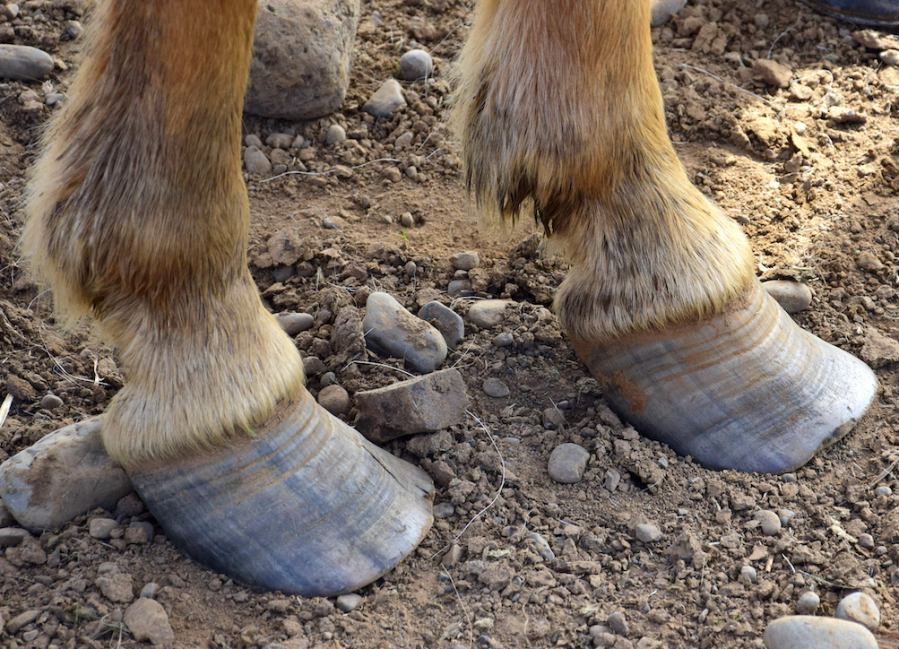
These horse hooves are overgrown
Many of the rescue horses Your Horse reports on are found with overgrown hooves. In a six-week shoeing cycle, the average horse hoof grows a quarter of an inch. A good exercise is to measure the length of your horse’s hoof from the front centre of the coronet band down to the toe clip on the shoe. Make a note of the length and remeasure the day your horse is being reshod. You could also take photos of the hooves at both stages as well, and then compare the difference.
The main problem with overgrown hooves is that it affects a horse’s balance. Rather than the whole hoof carrying their weight, the horse is forced on to their heels, affecting their movement and causing discomfort. Without regular farriery attention, hooves become overgrown very quickly.
You might be thinking that horses in the wild don’t have farrier check ups and they manage fine — and you’d be right. All the walking around a wild horse does on varying terrain helps to keep hooves at a healthy length. But kept horses typically don’t have this sort of freedom. Even if they are turned out 24/7, a grass surface alone is unlikely to keep an unshod hoof trim; and if your horse is wearing shoes (shod), it makes no difference at all.
I have seen overgrown horse hooves once before, when my farrier responded to an RSPCA case and asked for my assistance. There were five horses and ponies altogether. All hooves were so long that the front hooves had curled at the toe. The worst affected was a little grey Thoroughbred who was in so much pain she could barely move, and sadly she was put to sleep. The other four fully recovered.
Newborn horse hooves
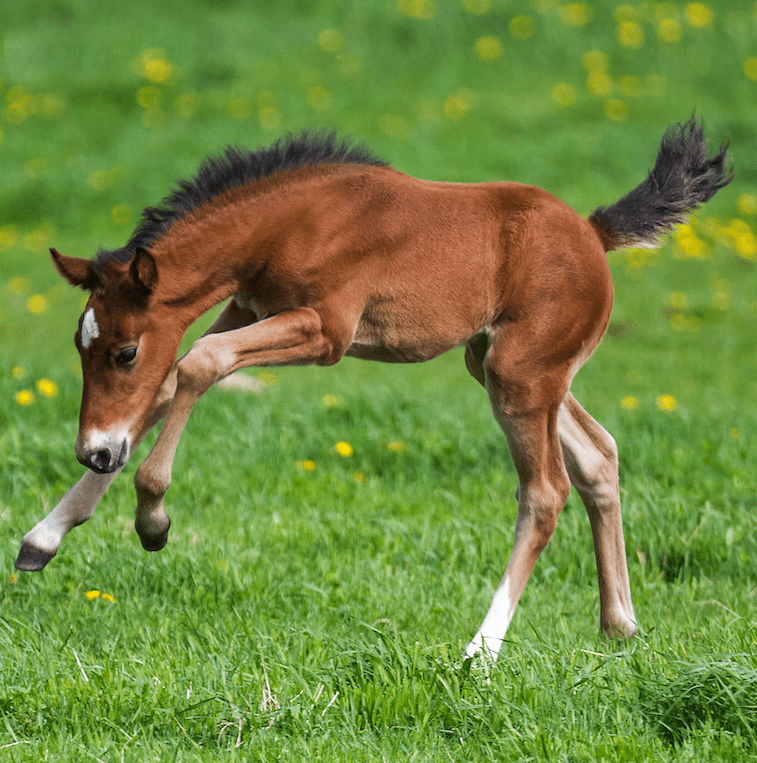
Newborn horse hooves are soft at first
Newborn horse hooves are fascinating. When a foal is born, their hooves are covered in eponychium. This is a soft covering designed to protect the mare’s uterus when she is pregnant (foals like to kick when inside their dam’s tummy) and when she gives birth. Foals pass through the birth canal front legs first, with their heads tucked in between them — so the first thing you’ll see if you witness a foaling are newborn hooves.
In the wild, remember, horses are prey animals and so a foal needs to get up and move after being born if it is going to survive. That is why a newborn has fully formed hooves.
Newborn hooves are made of the same horn tubules, keratin and lamellae as an adult horse hoof. Eponychium is deciduous hoof capsule, which means it will eventually fall off. Another term for it is ‘fairy fingers’ — the soft, rubbery newborn hooves do look rather fingerlike. There is a great image showing this here.
As soon as they are exposed to air, newborn horse hooves start to dry out and harden. It takes the eponychium a couple of days to fall off and the foal will be ready to see a farrier by the time they’re one-month-old, ready to start their regular horse hoof care routine. Newborn hooves grow at around 0.4mm per day — two times as quickly as an adult horse!
Main image: copyright Your Horse Library/Kelsey Media/Contemporary Captures. Other images: copyright Shutterstock
Related content
- Hoof abscesses: prevention and management tips
- Bruised soles in horses: common signs, causes and six ways to treat them
- Thrush in horses: what it is plus how to prevent and treat it
- Why hooves crack and how to prevent it
- How to poultice a hoof: Alan Davies’ step-by-step guide
- What to do if your horse punctures the sole of their hoof

